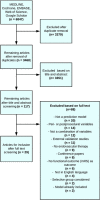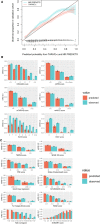Outcome Prediction Models for Endovascular Treatment of Ischemic Stroke: Systematic Review and External Validation
- PMID: 34732070
- PMCID: PMC8884132
- DOI: 10.1161/STROKEAHA.120.033445
Outcome Prediction Models for Endovascular Treatment of Ischemic Stroke: Systematic Review and External Validation
Abstract
Background and purpose: Prediction models for outcome of patients with acute ischemic stroke who will undergo endovascular treatment have been developed to improve patient management. The aim of the current study is to provide an overview of preintervention models for functional outcome after endovascular treatment and to validate these models with data from daily clinical practice.
Methods: We systematically searched within Medline, Embase, Cochrane, Web of Science, to include prediction models. Models identified from the search were validated in the MR CLEAN (Multicenter Randomized Clinical Trial of Endovascular Treatment for Acute Ischemic Stroke in the Netherlands) registry, which includes all patients treated with endovascular treatment within 6.5 hours after stroke onset in the Netherlands between March 2014 and November 2017. Predictive performance was evaluated according to discrimination (area under the curve) and calibration (slope and intercept of the calibration curve). Good functional outcome was defined as a score of 0-2 or 0-3 on the modified Rankin Scale depending on the model.
Results: After screening 3468 publications, 19 models were included in this validation. Variables included in the models mainly addressed clinical and imaging characteristics at baseline. In the validation cohort of 3156 patients, discriminative performance ranged from 0.61 (SPAN-100 [Stroke Prognostication Using Age and NIH Stroke Scale]) to 0.80 (MR PREDICTS). Best-calibrated models were THRIVE (The Totaled Health Risks in Vascular Events; intercept -0.06 [95% CI, -0.14 to 0.02]; slope 0.84 [95% CI, 0.75-0.95]), THRIVE-c (intercept 0.08 [95% CI, -0.02 to 0.17]; slope 0.71 [95% CI, 0.65-0.77]), Stroke Checkerboard score (intercept -0.05 [95% CI, -0.13 to 0.03]; slope 0.97 [95% CI, 0.88-1.08]), and MR PREDICTS (intercept 0.43 [95% CI, 0.33-0.52]; slope 0.93 [95% CI, 0.85-1.01]).
Conclusions: The THRIVE-c score and MR PREDICTS both showed a good combination of discrimination and calibration and were, therefore, superior in predicting functional outcome for patients with ischemic stroke after endovascular treatment within 6.5 hours. Since models used different predictors and several models had relatively good predictive performance, the decision on which model to use in practice may also depend on simplicity of the model, data availability, and the comparability of the population and setting.
Keywords: calibration; ischemic stroke; population; prognosis; publications; systematic review.
Figures



References
-
- Boehme AK, Rawal PV, Lyerly MJ, Albright KC, Bavarsad Shahripour R, Palazzo P, Kapoor N, Alvi M, Houston JT, Harrigan MR, et al. . Investigating the utility of previously developed prediction scores in acute ischemic stroke patients in the stroke belt. J Stroke Cerebrovasc Dis. 2014;23:2001–2006. doi: 10.1016/j.jstrokecerebrovasdis.2014.02.003 - PMC - PubMed
-
- Ishkanian AA, McCullough-Hicks ME, Appelboom G, Piazza MA, Hwang BY, Bruce SS, Hannan LM, Connolly ES, Lavine SD, Meyers PM. Improving patient selection for endovascular treatment of acute cerebral ischemia: a review of the literature and an external validation of the Houston IAT and THRIVE predictive scoring systems. Neurosurg Focus. 2011;30:E7. doi: 10.3171/2011.3.FOCUS1144 - PubMed
-
- De La Ossa NP, Rangaraju S, Jovin T, Davalos A. Validation of predictive scales of functional outcome after endovascular therapy using the revascat data. Conference start. 2016;47:AWP26.
Publication types
MeSH terms
LinkOut - more resources
Full Text Sources
Medical

